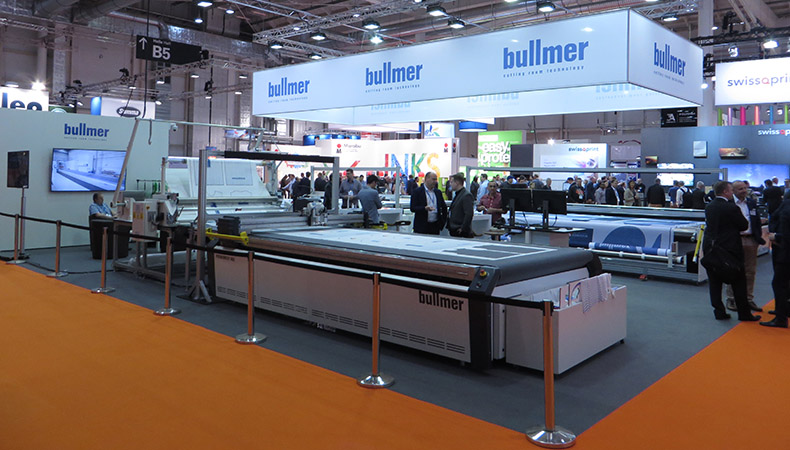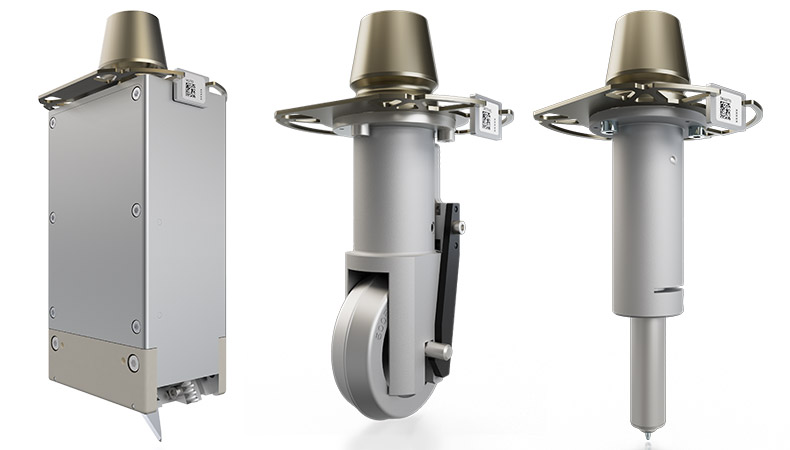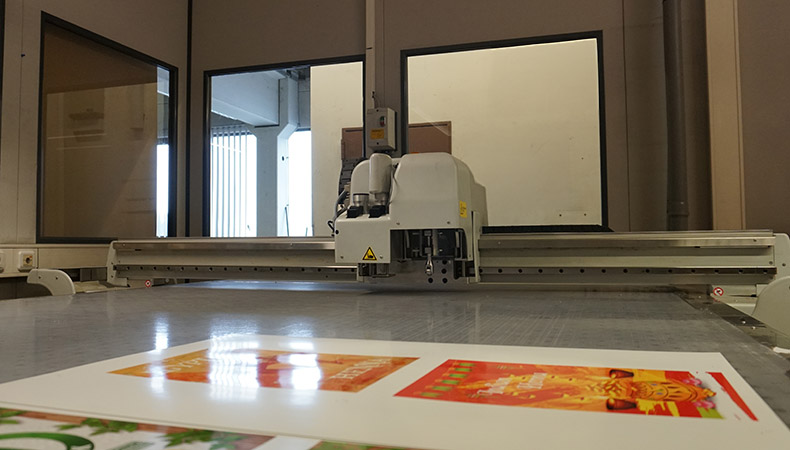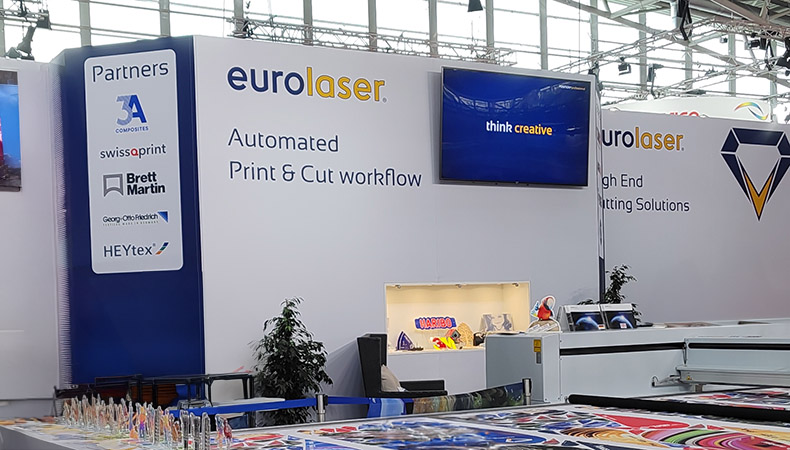This beginner’s guide provided by Sonja Angerer details the modular tools vital for digital cutting tables in printing and packaging. It explains the functions of various knives (drag, tangential, rotary), creasing wheels, milling heads, and specialized tools (kiss-cut, V-cut, laser). It emphasizes that tools are typically manufacturer-specific and are crucial for precise finishing like contour cutting and creasing.
A digital cutting table is indispensable in the modern printing and packaging industry. These machines enable precise cutting, creasing, perforating and many other steps in the production of POS displays, posters, ceiling hangers and other products.
Digital Cutting Table Tools Compatibility
The tools on digital cutting tables are modular but need to match the cutting table. Within models from the same manufacturer, tools are sometimes compatible with various series. This applies, for example, there are many tools in the S3, G3 and D3 series from Zünd Systemtechnik.
As a rule, however, tools cannot be used on the cutting solutions of other manufacturers. The modular tool system of Bullmer’s Premiumcut series is therefore not suitable for an Aristo cutting table. An Aristo multihead tool cannot be used on a Kongsberg cutter either. One exception is with the laser cutting tables from Eurolaser. This is because they can rely on tools from Zünd for mechanical processing.
Flatbed cutting plotters and cutting tables especially for the graphic industry are also available from Summa or Mimaki. CNC milling, plotters or print-and-cut machines can also be an alternative to the digital cutting table for certain applications.
Knives and wheels are considered consumables with a digital cutting table. They are available from the machine manufacturers as they must be replaced regularly for reliable quality output. However, as with inkjet inks, there are also third-party knives and wheels available on the market. Manufacturers usually recommend using their branded consumables as they are ideally suited for their modular tools.
 CAPTION: As a rule, tools cannot be exchanged between digital cutting tables from different manufacturers. Image Credit: Sonja Angerer
CAPTION: As a rule, tools cannot be exchanged between digital cutting tables from different manufacturers. Image Credit: Sonja Angerer
Cutting Tools for Digital Cutting Tables
Drag knife: The drag knife is one of the most frequently used tools on a digital cutting table. It is suitable for cutting a wide range of materials such as paper, cardboard, films and thin plastics.
Tangential knife: This knife is especially useful for cutting thicker and harder materials such as corrugated cardboard, foam, and rubber. The tangential knife moves at an angle that allows it to produce precise and clean cuts, even with complex shapes.
Rotary knife: It is mainly used for cutting textiles and flexible materials. It rotates during cutting, which allows for clean and efficient cutting without pulling or warping the material.
Creasing tools on the cutting table
Creasing wheel: It is used to create folding lines in materials such as cardboard and corrugated cardboard. These lines make it easier to fold. They also ensure clean, precise edges. Creasing wheels are available in a variety of sizes and shapes to suit different material thicknesses and requirements.
Creasing knife: Unlike the creasing wheel, the creasing knife cuts a flat line into the material without cutting it completely. This is especially useful for thicker materials where simple creasing is not enough.
 CAPTION: Tools for the Zünd Q-Line: V-Cut, Creasing Wheel, Drawing Tool. Image Credit: Zünd Systemtechnik.
CAPTION: Tools for the Zünd Q-Line: V-Cut, Creasing Wheel, Drawing Tool. Image Credit: Zünd Systemtechnik.
Perforating and milling tools for cutters
Perforating knife: This tool creates a series of small holes or slits in a material that make it easy to tear off or separate parts. Perforating knives are widely used in the packaging industry.
Milling Head: The powerful tool is used for cutting and engraving hard materials such as acrylic, wood, and aluminium. Milling heads are available in different sizes and shapes.
 CAPTION: Kongsberg cutting tables are particularly common in the packaging industry. Image Credit: Sonja Angerer
CAPTION: Kongsberg cutting tables are particularly common in the packaging industry. Image Credit: Sonja Angerer
Special tools on the cutting table
Drawing Tool: Creates marks or labels on various materials. For this purpose, it can be equipped with a wide variety of pens to create different colours and stroke widths.
Kiss-Cut Tool: This knife only cuts the top layer of a material without cutting through the layer underneath. This is especially useful for the production of stickers and labels where the backing material must remain intact.
V-Cutting tool: The V-Cut cuts V-shaped grooves in materials such as foam and corrugated cardboard. These grooves allow the material to be folded at sharp angles, which is useful for creating three-dimensional structures.
Ultrasonic Cutting Module: An ultrasonic cutting head on a digital cutting table is mainly used for precise and clean cutting of fibre and composite materials. The heat generated in the process seals the edges of PVC banners or soft signage applications.
Laser tool: A focused CO2 laser beam replaces the knife, evaporating a tiny amount of the material instead of actually cutting it. Laser cutting is mainly used for Soft Signage polyester textiles as edges are immediately sealed and do not fray.
 CAPTION: Eurolaser cutting tables can also be equipped with Zünd cutting tools. Image Credit: Sonja Angerer
CAPTION: Eurolaser cutting tables can also be equipped with Zünd cutting tools. Image Credit: Sonja Angerer
Conclusion
Digital cutting tables are an important part in automating workflows in the printing industry. Today, most have a modular design, so that the tools can be replaced as required.
Cutting tables for particularly high throughput, such as the Zünd Q-Line or the G3 cutters, can also offer automated tool management with several tools preloaded. The machine switches to the tool required for the task or to a tool head with a fresh knife with the help of software.
It is true that very small runs and individual pieces are still sometimes cut and creased manually in digital printing and sign-making. With most printers, a digital cutting table with powerful tools has though become an indispensable part of production.